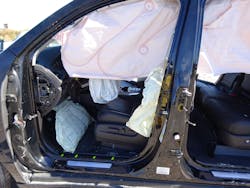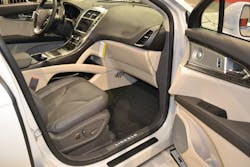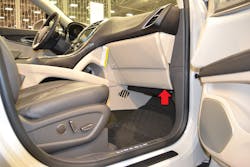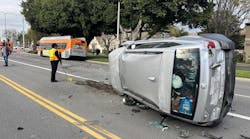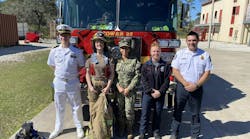Topic: Kneebag update
Objective: The rescue team shall understand kneebag identification techniques and recognize the potential risks when kneebags are undeployed
Task: Develop a protocol for detecting an undeployed kneebag when accomplishing a dash-rolling or dash-jacking vehicle rescue extrication task
As a result of a hard-impact collision, the driver and/or front passenger of an automobile might be trapped. If the dash, pedals, instrument panel, column and/or floorboards are trapping the individual(s), many rescue teams utilize a dash-rolling or dash-jacking evolution to free the driver and/or front passenger.
When undeployed kneebags are present, specific procedures or steps should be taken into consideration by rescue and EMS personnel when: sizing up the crash-damaged vehicle; working inside of the vehicle; and completing the dash evolution.Size-up
Rescue personnel must be able to recognize the presence of an undeployed kneebag at a crash scene. There might be a driver’s and/or passenger’s side kneebag.
However, it’s important to realize that not all crashes cause a kneebag to deploy. Intended as a supplemental restraint system for a frontal collision, the kneebag might not deploy in a rear, side or rollover crash. Furthermore, one kneebag might deploy in a crash and a second kneebag on the other side might not. For example, with an empty passenger’s front seat, it’s possible for the lone driver to be trapped although the passenger’s side frontal airbag and kneebag didn’t deploy.
Kneebag technology began to make its way into automobiles for the U.S. market in the mid-1990s, so the presence of kneebags shouldn’t come as a surprise to rescuers. Select models of newer vehicles include one or two kneebags as part of their occupant passive restraint system.
Regardless of vehicle age or manufacturer, kneebag systems utilize pressurized stored gas inflators to inflate the bag, typically at 4,000 psi or greater. It is this inflator module that should concern rescuers.
If a kneebag deployed, the stored gas inflator that’s directly connected to that bag is empty, or devoid of pressure, and presents essentially no risk to personnel. There are no two-stage or dual-stage kneebag inflators at this time.
Rescue officers and vehicle rescue instructors should train their personnel to search for any undeployed kneebag at a crash scene. This process only takes a brief moment and should become an essential element of size-up, particularly when the planned extrication work involves moving the dash, instrument panel or firewall structure.
Most kneebags—but not all—have a label or marker, although that isn’t required by federal law. Responders refer to this marker as the airbag ID. To be realistic, even when a label/marker is present for a kneebag, the ID doesn’t indicate the location of the kneebag nor the location of the stored gas inflator.
Airbag IDs for kneebags should be considered simply as a means of “advertising” that a kneebag is present somewhere in the area of the ID. If present, the ID for a driver’s kneebag usually is low on the instrument panel and difficult to see, because it typically is color-coded the same color as the instrument panel. Several Ford vehicles’ driver’s kneebag IDs are located along the outer edge of the instrument panel, which means that they aren’t visible until the front door is fully open.Working inside
Rescue and EMS personnel who work inside of a crash-damaged vehicle must by now be well-aware of what has been dubbed the “inflation zones” of airbags. The easy-to-remember inflation equation of “10-20-5” reminds responders that a typical driver’s airbag deploys outward toward the driver occupant a distance of approximately 10 inches at the moment that it’s fully deployed, and that the passenger frontal airbag deploys approximately 20 inches at full inflation.
The number “5” in the inflation equation reminds us that a typical side-impact airbag is approximately five inches thick at its full inflation, this despite the fact that roof-mounted side-impact airbags might be six feet or more in length. Seat-mounted side-impact airbags also generally are five inches thick. So, too, are kneebags.
Completing extrication tasks
Rescuers must understand that kneebag systems are designed to deploy in frontal or off-set-frontal collisions. A serious rear-end or side collision might trap occupants inside but not deploy a kneebag. If the kneebag doesn’t deploy, the pressurized gas that’s inside of the inflator cylinder remains. Shutting off the ignition and taking away the electrical power doesn’t release any of the stored gas pressure. Any unintentional cutting, crushing or puncturing of this cylinder by a rescue tool during a dash job can result in a catastrophic failure of the unit.
The greatest potential for risk comes from the fact that the driver’s kneebag gas inflator module typically is at the very end of the instrument panel, right where a rescuer would work to accomplish a dash-rolling or dash-jacking evolution.
As a vehicle rescue instructor, this author integrates checking for inflators into his protocol for dash-rolling and dash-jacking via the acronym FIAT. The ‘F’ reminds personnel who set up for a dash assignment to move the fender to clear the lower A-pillar work area. The ‘I’ reminds to check for the presence of an undeployed kneebag inflator. The ‘A’ reminds the crew of the new and preferred method to cut through the A-pillar. The ‘T’ reminds personnel to attack any dash tie downs if they are present and can be accessed.
The kneebag assumption
With modern-vintage vehicles, rescuers should consider that kneebags are present in all crash-damaged passenger vehicles until proven otherwise. Assuming that they are present and then confirming that they are or are not should be protocol.
Safety hinges on early identification of any undeployed kneebags. Proficiency in scanning for kneebags during size-up is a vital skill.
